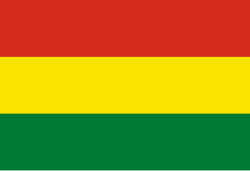 | |
| La Tricolor ('The Tricolor') | |
| Use | Civil flag and ensign |
|---|---|
| Proportion | 15:22 |
| Adopted | 31 October 1851 |
| Design | A horizontal tricolor of red, yellow and green |
| Designed by | Manuel Isidoro Belzu |
 | |
| Use | State flag and ensign, war flag |
| Proportion | 15:22 |
| Adopted | 31 October 1851 |
| Design | A horizontal tricolor of red, yellow and green with the coat of arms |
| Designed by | Manuel Isidoro Belzu |
| Wiphala | |
 Dual flag | |
| Use | National flag |
| Proportion | 1:1 |
| Adopted | 7 February 2009 |
| Design | Banner composed of a 7-by-7 square patchwork in seven colours, arranged diagonally. |
 Maritime flag | |
| Use | Naval ensign |
| Proportion | 2:3 |
| Naval jack | |
 Naval jack | |
| Proportion | 1:1 |
| Design | A red, yellow and green square. |

The national flag of the Plurinational State of Bolivia was originally adopted in 1851. The state and war flag is a horizontal tricolor of red, yellow and green with the Bolivian coat of arms in the center.
Contents
- Description
- Design and dimensions
- Color and symbolism
- Historical flags
- See also
- References
- External links

According to the revised Constitution of Bolivia of 2009, the Wiphala is considered a national symbol of Bolivia (along with the tricolor flag, national anthem, coat of arms, the cockade; and kantuta and patujú flowers). [3]
Despite its landlocked status, Bolivia has a naval ensign used by navy vessels on rivers and lakes. It consists of a blue field with the state flag in the canton bordered by nine small yellow five-pointed stars, with a larger yellow five-pointed star in the fly. The nine small stars represent the nine departments of Bolivia, and the larger star the nation's right to access the sea (access that it lost in 1884 in the War of the Pacific).









